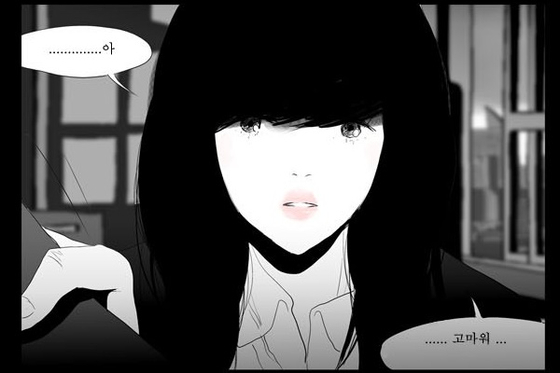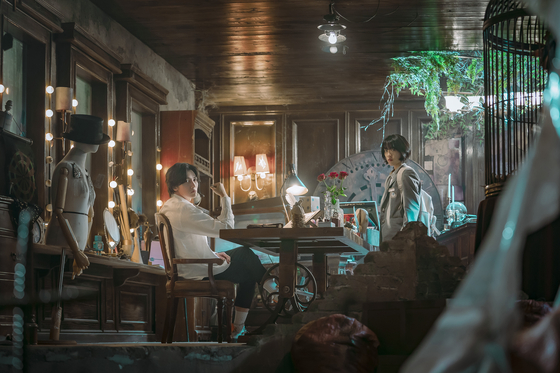[WEBTOONS REIMAGINED] Adaptation of 'Annara Sumanara' sprinkles some musical magic on the original
![The magician that Ji Chang-wook portrays in the Netflix series "The Sound of Magic," left," is different from the original character from the webtoon "Annara Sumanara." [NAVER WEBTOON, NETFLIX]](https://koreajoongangdaily.joins.com/data/photo/2022/05/23/8905226c-2d27-4107-b453-121bef2d6081.jpg)
The magician that Ji Chang-wook portrays in the Netflix series "The Sound of Magic," left," is different from the original character from the webtoon "Annara Sumanara." [NAVER WEBTOON, NETFLIX]
Webtoon, a compound word of web and cartoon, refers to a type of digital comic read on smartphones. This genre has become a treasure trove for creators who adapt their narratives into a live-screen format. The concept has been popular with Korean viewers since the early 2000s, but foreign viewers are now finding out their favorite films and drama series, such as Netflix’s “Hellbound” (2021), “Sweet Home” (2020), “Yumi’s Cells” (2021),“My Roommate is a Gumiho” (2021) on tvN, “Itaewon Class” (2019) on JTBC, “The King’s Affection” (2021) on KBS and most recently “All of Us Are Dead” on Netflix, have all been adapted from webtoons. In Webtoons Reimagined, the Korea JoongAng Daily attempts to compare and contrast the adapted works and the webtoon originals to take a closer look at the narratives that have seen success with Korean and international viewers alike.
Fans of Netflix Korea’s musical drama series “The Sound of Magic” will be surprised to know that the mysteriously alluring magician named Lee Eul, portrayed by actor Ji Chang-wook, could not be more different from the character he is based on in the original webtoon “Annara Sumanara.”
Since its release on the streaming platform on May 6, the series ranks No. 4 on the weekly Top 10 Global chart in the non-English TV category from May 9 to 15 and has been streamed over 16.93 million hours.
Netflix Korea’s first attempt at showcasing a musical drama series centers around a high school student named Yoon Ah-yi who has given up on her childhood dream of becoming a magician due to poverty. However, her faith in magic is rekindled by a magician, Lee Eul, who lives in an abandoned amusement park near her town and his magical words, “Annara Sumanara.” However, Lee Eul is not a typical adult and soon others in the town begins to suspect that he is behind crimes taking place.
One of the biggest differences between the webtoon and onscreen characters are their outward appearances. Granted, both magicians are exceptionally handsome, however, while the 2-D character sports short, almost-blond hair with shapely monolid eyes and a thin figure, the Netflix version has long, wavy black hair with defined double-lid eyes and a sturdy build. Ji also flaunts a more hip, stylish wardrobe than the webtoon, which mostly sees the character stick to a formal magician suit. The only physical similarity lies in their height.
Other protagonists — Ah-yi and Il-deung — portrayed by Choi Sung-eun and Hwang In-youp, have more similarities to their original characters. Series adapted from webtoons tend to have stricter casting protocols in a bid to choose actors that will satisfy the high expectations of fans who eagerly anticipate seeing their favorite webtoon characters come to life on screen.

Ah-yi from the original Naver webtoon "Annara Sumanara"
![Two teenage protagonists — Ah-yi and Il-deung — are portrayed by Choi Sung-eun and Hwang In-youp [NAVER WEBTOON, NETFLIX]](https://koreajoongangdaily.joins.com/data/photo/2022/05/23/bfdfe451-f3b2-4b5d-99e8-403b9f5edbfb.jpg)
Two teenage protagonists — Ah-yi and Il-deung — are portrayed by Choi Sung-eun and Hwang In-youp [NAVER WEBTOON, NETFLIX]
However, director Kim Sung-yoon, who is behind hit drama series such as “Discovery of Love” (2014), “Love in the Moonlight” (2016) on KBS and “Itaewon Class” (2020) on JTBC, said that he didn’t take much care when it came to matching actors’ physical attributes to the characters in the webtoon.
“Regarding the physiques and the wardrobes of the actors, I don’t think there is any actor who could exactly mimic the looks of the original characters,” Kim said during a recent online interview. “There are certain looks and colors that suit an actor, which are amplified with the charisma that they have. If you enforce a specific outfit [from the original work] on an actor without regarding whether or not it really suits them, then it would only make [the character] less appealing. I believe that it is all about how the actors balance each other out when it comes to casting. For instance, if the Ah-yi that Choi Sung-eun portrays retains a more sorrowful appearance than the original work, than to balance her out, Hwang In-youp would possess more vitality, and Ji would be more childlike, cute and playful.”
Kim also revealed that he deliberated until the last minute of production about whether or not he should release the series in black-and-white, like the webtoon is.
In the webtoon, except for Ah-yi’s pink lips and Lee Eul’s magic scenes, every other aspect is portrayed in black-and-white, representing Ah-yi’s dreary, dismal reality in sharp contrast with the fantasy and the wonders of Lee Eul’s magic.

![The abandoned amusement park that Lee Eul resides in from "The Sound of Magic," top, and "Annara Sumanara," above. [NAVER WEBTOON, NETFLIX]](https://koreajoongangdaily.joins.com/data/photo/2022/05/23/b9f806b7-294d-4550-96a2-1a870d11a18e.jpg)
The abandoned amusement park that Lee Eul resides in from "The Sound of Magic," top, and "Annara Sumanara," above. [NAVER WEBTOON, NETFLIX]
“As we were turning this into a live-action series, we could already feel everything Ah-yi is going through — she is knee-deep in poverty and she is [constantly] agonizing and wrestling with it,” Kim said. “So we didn’t think it was necessary to turn the scenes into black-and-white.”
The webtoon, drawn and written by cartoonist Ha Il-kwon between 2010 and 2011, is unique thanks to its surreal setting, but it is this very aspect that makes it hard to adapt into a series.
For instance, when Il-deung’s parents are putting pressure on him to do well academically, they grow so large that they fill the whole room and loom down over their son. Il-deung’s home seems to be a collage of everything that is beautiful and expensive but looks haphazardly precarious, much like the emotional turmoil that Il-deung feels when he begins to realize that his “dream” to go to a prestigious university and land a respectable job may not be his own. Director Kim, who has known Ha for a decade now, said that he was always a fan of his friend’s work.
“When I met Ha [a decade ago] I’ve heard that the copyright for ‘Annara Sumanara’ was already sold,” Kim said. “Seven years after that, I met Ha again and he told me that the copyrights for eight of his webtoon works were sold but none of them had been adapted onto the screen yet. Ha seemed to be a bit crestfallen about that so I promised him that I would adapt ‘Annara Sumanara.’ I personally am proud that I kept my promise, but visualizing the webtoon was extremely difficult [...] Because there are certain aspects of Ha’s imagination that are so unique, fantastical and hard to visualize.”
![Hwang In-youp portrays the elite student named Il-deung who has a crush on Ah-yi in the Netflix series [NETFLIX]](https://koreajoongangdaily.joins.com/data/photo/2022/05/23/7c28f396-3486-453d-bb0c-4c5191489170.jpg)
Hwang In-youp portrays the elite student named Il-deung who has a crush on Ah-yi in the Netflix series [NETFLIX]
![Il-deung from the webtoon "Annara Sumanara" [NAVER WEBTOON]](https://koreajoongangdaily.joins.com/data/photo/2022/05/23/bb00b337-ba2a-4f89-a7e1-a6a927a1dd8e.jpg)
Il-deung from the webtoon "Annara Sumanara" [NAVER WEBTOON]
From the beginning, Kim decided that the opening sequence should feature music. Whenever the protagonists have an emotional monologue, they break into song.
Kim said that the musical element acts as a means to convey the character’s emotional status through the screen.
“I didn’t start production with the idea that this would be a musical series,” Kim said. “[Music] is just part of the concept, like the characters’ clothes — to help maximize the emotions that Lee Eul and Ah-yi feels. However, it was difficult to naturally infuse those scenes, not to feel like the characters are suddenly bursting into songs but rather so that it feels like they’re having a heart-to-heart conversation.”
Kim also discussed the positive reviews related to the post-credit scene, when all of the characters appear on stage, beaming and smiling — whether they have a tragic or a happy ending — for a curtain call in front of an eager crowd.
“I wanted to close the series with music since I started it with music,” he said. “The curtain call was included to indulge the fans’ wishes, as if [the whole series] was part of a play. I was worried that the scene would clash with the series’ ending, or that the viewers might feel that it is too inconsistent with the ending [...] but to my relief, people loved it. I think the viewers have now progressed to understand how to separate the narrative and the characters. They were simply happy to see the characters they’ve grown to love to be happy and singing.”
While the characters may stray from their originals, the series follows the webtoon’s narrative to a tee. It is a coming-of-age story following Ah-yi and Il-deung who rediscover their dreams after losing them to grown-ups. Ironically, this is done through the help of an adult magician who wishes to remain a child.
Although fantasy elements exist within the narrative, the story deals with struggles that all teenagers, and perhaps even adults, face that seem ubiquitous and timeless: What does it mean to achieve success and would you be happy if you got what you always wanted? What does it mean to become a “good” adult? How do you become socially accepted and does that bring happiness?
Director Kim wants viewers to mull over the above questions as people watch the series.
![A scene from the Netflix series which was almost exactly adapted from the original webtoon as Ah-yi chases a 50,000 won bill that gets swept up in a wind. [NETFLIX]](https://koreajoongangdaily.joins.com/data/photo/2022/05/23/15415bc7-165c-4807-b240-5c5d07cc4bc6.jpg)
A scene from the Netflix series which was almost exactly adapted from the original webtoon as Ah-yi chases a 50,000 won bill that gets swept up in a wind. [NETFLIX]
“What does it mean to grow up and to become an adult?” Kim pondered. “I think that’s something that adults can think over and discuss with their children. When you watch the series, the main antagonists in the story are the adults. They are the ones giving a hard time to the children, trying to impose and shape their dreams and desires based on what they ‘believe’ is the proper course.”
The director said that the core message of both works remain the same.
“The original message was to tell a girl who’s given up on her dream to not to [give up],” he said. “However, after a decade since the webtoon’s release we thought the concept of a dream was too ambiguous in contemporary society, which is why, after much discussion with Ha, we altered the message a little bit to say that the premise of happiness does not lie with having a dream. One can be happy without having to feel that they should be ambitious or conforming to others’ standards.”
BY LEE JAE-LIM [lee.jaelim@joongang.co.kr]










with the Korea JoongAng Daily
To write comments, please log in to one of the accounts.
Standards Board Policy (0/250자)